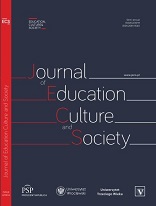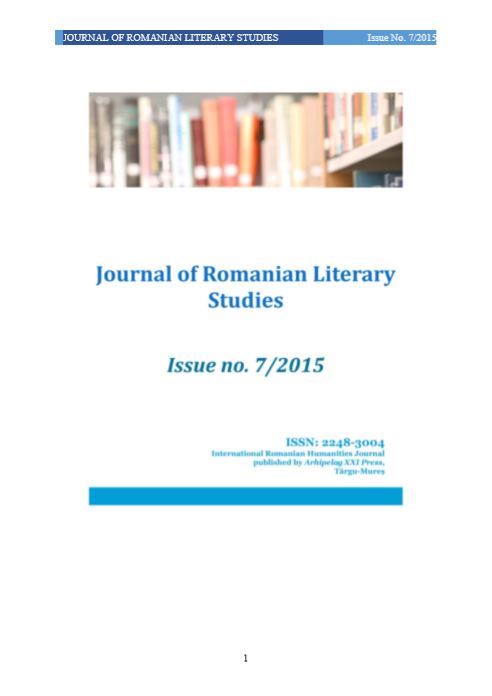


Keywords: Mihai Eminescu; limba română; cultura română veche, arhaisme; carte veche
Preoccupied of literature, linguistics, philosophy and history, Mihai Eminescu remained in Romanian cultural history not only due to its remarkable literary writings and literary language, but also because his ideas about language and style, and concepts of the Romanian language and national literature. For understanding and analysis his work, the technique used in the interpretation must be a complex one, which includes the quest of the sources of inspiration and the influence exerted on his of the Romanian old culture. This is because numerous representative writings of the Romanian old culture constituted the subject of his researches and, charmed by the beauty of the Romanian old language, the archaisms and the eloquence of the expressions, Mihai Eminescu has not hesitated to transcribe them in his own manuscripts, and then to use them in his writings.
More...Keywords: circulation of the poems by Mihai Eminescu; sense constructions; the art of translation; European area
The charge of bringing back to life, the beauties of the Romantic poems written by the Romanian Eminescu, is not easy. A good translation requires more effort, so that you can rebuild the souls moments of the poet's creation or to make a better approximation. More than the appropriate conditions, an affinity of temperament needs to be created, a similar moral climate between the translator and the interpretation. The translator would otherwise have a problem while trying to make Eminescu’s poems circulate in the spiritual space of the people of letters worldwide. Even though there are many difficulties when translating his artistic temperament into other languages, there are, nowadays, around 600 titles and editions of his poems, which have the rigour of professionalism confess similar physiognomies and the translator’s talent. Many translators have, by a major meeting of meanings, of atmosphere, of echoes with the original, made great creations. Pictures will prove, hopefully, the above-mentioned statements.
More...
Keywords: Time; ontological model; Mihai Şora; Phenomenology; consciousness of time; the temporality of the Moment; intersubjectivity; “the gift of Encounter”; dialogical philosophy; empathy; relation; authenticity
The present contribution has the purpose of evidencing both the originality of Şora’s understanding of time (and its importance for the question of authenticity, empathy and intersubjectivity), and the possibility of a dialogue with Husserl’s understanding of the consciousness of internal time. One of the most important aspects of my paper is the endeavour to bring to light the underlying structure of temporality at work in Mihai Şora’s philosophy. The two forms of temporality present in Şora’s thought – the temporality “of the Moment” and that “of the instances of countable time” – open up the possibility of a phenomenological understanding of time. Some specific terms which Şora uses to describe the two forms of temporality – like the “vertical plunge”, “openness”, “disclosure”, “the gift of Encounter”, “the horizontal walk”, etc. – seem, at least at first, to belong to a poetic language, full of metaphors, a language which doesn’t seem to have much in common with the rigors of a philosophical language, but they nevertheless reveal some fundamental characteristics of the two forms of temporality. The possibility of understanding and interpreting these forms of temporality as structures belonging to the consciousness of time, in a broad sense (which correspond to the fabric of the real word, according to Şora’s ontological model), is another interesting question which will be debated in the present study.
More...
Keywords: national poet; literary history; Mihai Eminescu; romanticism; literary dictionaries
Mihai Eminescu is known as the Romanian national poet, the most im-portant writer of the XIXth century in Romanian literature, whose writ-ings have been intensely interpreted since his poetic debut. Therefore, this paper proposes a study of the way the literary dictionaries build the image of “the national poet”. This identity construct is significant to our investigation because it influences the interpretation of the poet’s figure through history. In order to have a wider view of the problem, we con-sulted a series of literary dictionaries and also dictionaries for students use to see how the figure of Eminescu is taught in schools. Moreover, we did not put aside foreign dictionaries, which bring a more objective per-spective to the issue. The majority of Romanian dictionaries alter the po-et’s portrait in favor of a “national construct”, created partly by the use of rhetoric figures. Another way of composing him a deformed image is accomplished by writing subjective and opaque interpretation of his po-ems. Consequently, such hermeneutics focuses on developing a myth that reflects mainly the way Romanians as nation want to be recognized and remembered.
More...

Keywords: critical reception; fantastic prose; influences; Mihai Eminescu; interpretation
Unlike his poetry, which was immediately accepted and powered by the critical consciousness and the public, Mihai Eminescuřs prose had to go a long way before being acknowledged, and analyzed. This happened mainly because of the small number of writings published during his life, and because of his type of fantastic prose, which was full of strong philosophical influences. In all of its representations, his prose meets the condition of comparison with the European creations of this particular genre. Beyond its originality, Mihai Eminescuřs prose represents a full integration into a vast concert of symbols, myths, ideas of great universal circulation, and thus, it ensures the permanency of his writings. Beyond these external references, which are, however, crucial in order to understand the value of his fantastic prose, we must emphasize the important role that the aforementioned influences played in the Romanian literature and in its directions developed by the writers of the entire 20th century
More...Keywords: Mihai Viteazul; relations; Saxons; Transylvania;
The author presents the relations of Mihai Viteazul (1593-1601) with the Saxons of Transylvania before and after the union of it, realized by the prince of Wallachia after the battle of Şelimbăr, 1599.
More...
Keywords: Transnistrian Conflict; Chronology; Bibliography, Working instruments
The volume "The Transnistrian Conflict Chronology" by Mihai Melintei, edited and printed by the ARMANIS Publishing House in Sibiu in 2018, represents the research product within the Laboratory for the Transnistrian Conflict Analysis (research structure of the "Lucian Blaga" University of Sibiu).The main goal of research is offering an analyzing and working instrument useful for both public interested in the Transnistrian problem and for those who has concerns in the area of the management of conflicts.We can read here the only achievement in the literature for the Transnistrian conflict, which links the event with a bibliographic source (written mainly in Romanian and Russian, but sometimes also in English or Ukrainian). And not just a source; each event has a tabular allocation for two, three or even four bibliographic sources - which gives the reader the opportunity to go to sources and deepen the subject matter of his interest, in a detailed, nuanced and objective manner. A final review of the bibliography used during the research, proposed by the author at the end of the paper, shows impressively: 1665 titles, which are books, studies, articles or documents.The book impresses throughout its dimension - to be more precisely, 450 pages in A4 format.
More...
Keywords: Mihai Eminescu; Romanian poet; poetry; works; the Romanian and Italian culture; Italian Romantic poets; European Romantic poets;
The undeniable genius of the Romanian poetry, Mihai Eminescu belongs to great family of the European Romantic poets. Both his culture and his Dionysian sensibility bring him closer to the Italian Romantic poets. His poetry could be set on two levels: that deep and mysterious one that leads to a mystical knowledge of the universe and the romantic and wanderering level, more accessible, more transparent and often with a classic rhythm.
More...
Keywords: Basarabia; arguments; patriotism; feeling; nationalism;
The present paper aims to bring in attention other important side of the poet Mihai Eminescu – his patriotic feelings, which are revealed in the publicistic work. The poet proves a remarcable inner force, in spite of his anger and sadness, in demonstrating that Basarabia belongs to our country. Eminescu was a patriot and his publicistic articles create a whole image of this dimension which comes from the bottom of his Romanian heart.
More...
Keywords: The King Mihai I; visit to Romania; Archbishop Pimen; King privileges;
The article evokes a visit that the former sovereign of Romania, King Michael I, made to Romania in 1992. It was the first visit after his forced abdication of December 30, 1947 at the invitation of Archbishop Pimen of Suceava and Radauti. The king attended the Resurrection service at Putna monastery and then other events in the country, being welcomed everywhere with great honors.
More...
Keywords: Mihai Papadopol; Faculty of Biology – University of Bucharest; hydrobiology; ichthyology; astacology
The article pays pious homage to Romanian hydrobiologist Mihai Papadopol (1927–1992). He studied Law and Natural Sciences, and he obtained a Doctoral degree in Biology from the University of Bucharest following the defense of a Doctoral dissertation on the biology of Cyprinid fish from Romania. He published 76 scientific papers in various journals published by the University and Romanian Academy. He was a member of the International Societies of Limnology (The Netherlands) and Astacology (USA).
More...
Keywords: tehnical progress; informatics revolution in Romania; tehnological evolution;
The author of this paper has had the honor to work together with academician Mihai Drăgănescu more than fourteen years. In this paper, after a short introduction, the author tries to tell us what he has learned about academician and he presents Mihai Drăgănescu as pioneer and promoter of the informatics’ revolution in Romania. In the last part of the paper, the author pointed out which is the role of Mihai Drăgănescu for the present ant the future as an example of the one high scientific personality who has been conscious of the aspirations of the epoch of his life and through a creative, competent and responsible activity conceived scientific and managerial works which are examples for us and for our followers.
More...
Keywords: Algebraic calculus; Algebra; symbolistic logic; pedagogical talent;
130 years after the premature demise of one of the leading figures of Romanian culture, Mihai Eminescu, we will attempt to have a closer look into the depth of his ideas, his research projects that were bestowed upon the Sciences, and, primarily, upon the queen of all sciences, which is to say, mathematics. We will be highlighting some mathematical aspects, namely the ones discussed in his work1, all the while taking into account the level of development in mathematics, in the 19th century.
More...
Keywords: Bessi; Mihai Bravu; Moesia Inferior; vicus Bad[---]; rural life
The article analyzes the texts in which the name of Bessi at Mihai Bravu (northern Lower Moesia) is attested. It seems that one of the oldest mentions of Bessi to the north of the Roman province of Moesia Inferior is a military diploma issued by Vespasian for Tarsa, at Mihai Bravu. This research tries to explain the early presence of the Thracian tribe in this part of the province.
More...
Keywords: Delirium tremens; complication; alcoholism;
Review of: Adriana Mihai, Delirium tremens: o complicaţie a alcoolismului, Cluj-Napoca, Editura Risoprint, 2007, 156 p.
More...
Keywords: Professor; Mihai Mitu; at 75 years old;
Scientific Life: Profesorul Mihai Mitu la 75 de ani (Mariana Mangiulea)
More...
Keywords: Professor Mihai Mitu; 70th birthday; Philology;
Scientific life: Profesorul Mihai Mitu la a 70-a aniversare (Mariana Mangiulea)
More...